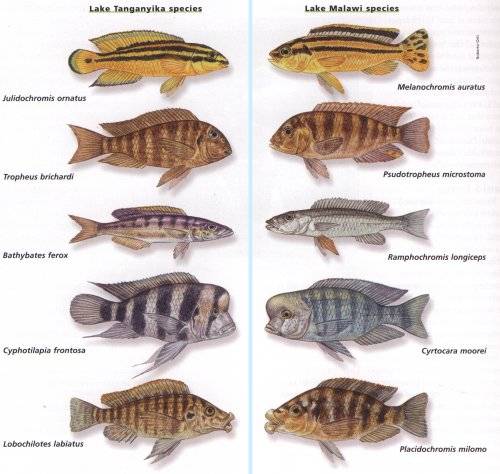African Cichlids are one of the most speciose groups of fish on the planet and have received a lot of attention from evolutionary biologists due to their explosive radiation. These fish produce new species faster than any other vertebrate on the planet with hundreds of species evolving in the last 120,000 years in Lake Victoria. To put this into context this is much less than the amount of time humans have been a species. One of the reasons for this is due to sexual selection. African cichlids are well known for identifying species specific patterns and colour when selecting mates. This indicates that the use of visual sensory systems is important in this group of fish and a recent study by Meadows (2009) shows how visual tuning may boost African cichlid diversity.
Researchers compared visual sensitivity between cichlids from Lake Malawi, where the water is clear, and cichlids from Lake Victoria, where the water is more turbid. They found that Malawi cichlids were divided into those with opsins that were sensitive to short, medium and long wavelengths. Opsins are a protein that forms part of the visual pigment rhodopsin that is released by the action of light. In Malawi cichlids opsin sensitivity was tuned largely by foraging. For example, cichlids that fed on plankton in the water column had more short wavelength opsins. Short wavelength opsins make a fish more sensitive to ultraviolet light and this is known to increase the fishes ability to detect zooplankton. In contrast, none of the Lake Victoria cichlids showed ultraviolet light sensitivity and instead were most sensitive to red light. In turbid water ultraviolet light is rapidly absorbed and thus it would be maladaptive to be sensitive to this spectrum of light. What they did find is that a gradient existed in fish sensitive to violet light with those found in the clearer parts of the lake showing most sensitivity to violet light, which would provide an advantage when feeding in clear water.
http://www.accuracyingenesis.com/cichlids.jpg
The researchers then showed that changes in gene expression generated large scale shifts in opsin sensitivity (30-100 nm), while changes in DNA sequences fine-tuned opsin sensitivity by 5-10 nm at the extreme ends of their visual range. This could provide a basis for the rapid number of species generated in such a short evolutionary time frame. By changing the way these cichlids see each other and their environment, shifts in opsin sensitivity could lead to changes in their mating and feeding behaviour thus driving speciation.
However, my own research has shown that some cichlids make very good non-visual hunters also. During my postdoc I showed that a Lake Malawi Cichlid from the genus Aulonocara was able to feed using the mechanosensory lateral line. This sensory system is a hair cell based system that detects minute water movements surrounding the fish. Species of Aulonocara are unique in that they possess widened membranous canals, a morphology normally found only in deep sea fish. These fish search similar to a metal detector picking up on the respiratory currents of buried invertebrates within the sand. I also observed these species undertaking aggression and courtship displays within complete darkness. I assume that these behaviours were also mediated by the lateral line. This genus of Aulonocara is one of the most speciose of the African cichlids, and therefore vision may not be the only factor to consider in their rapid speciation.
Meadows R (2009) Visual Tuning May Boost African Cichlid Diversity. PLos Biol 7 (12)




No comments:
Post a Comment